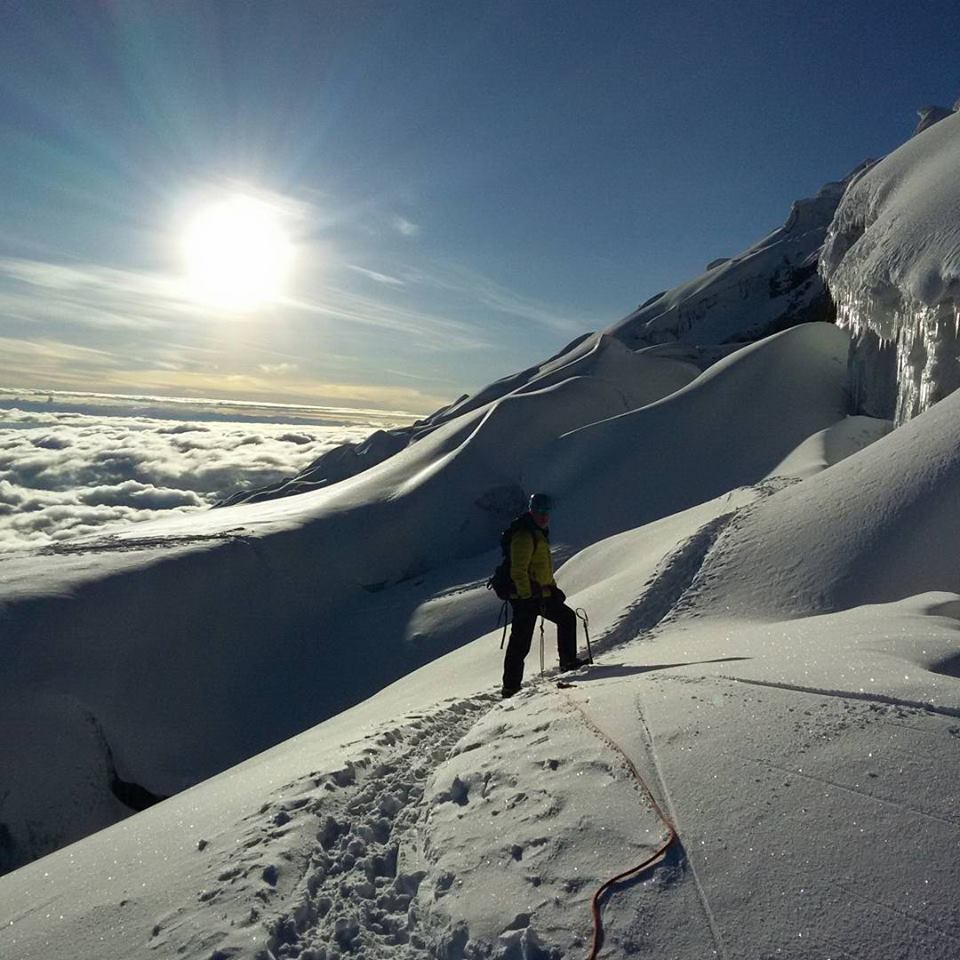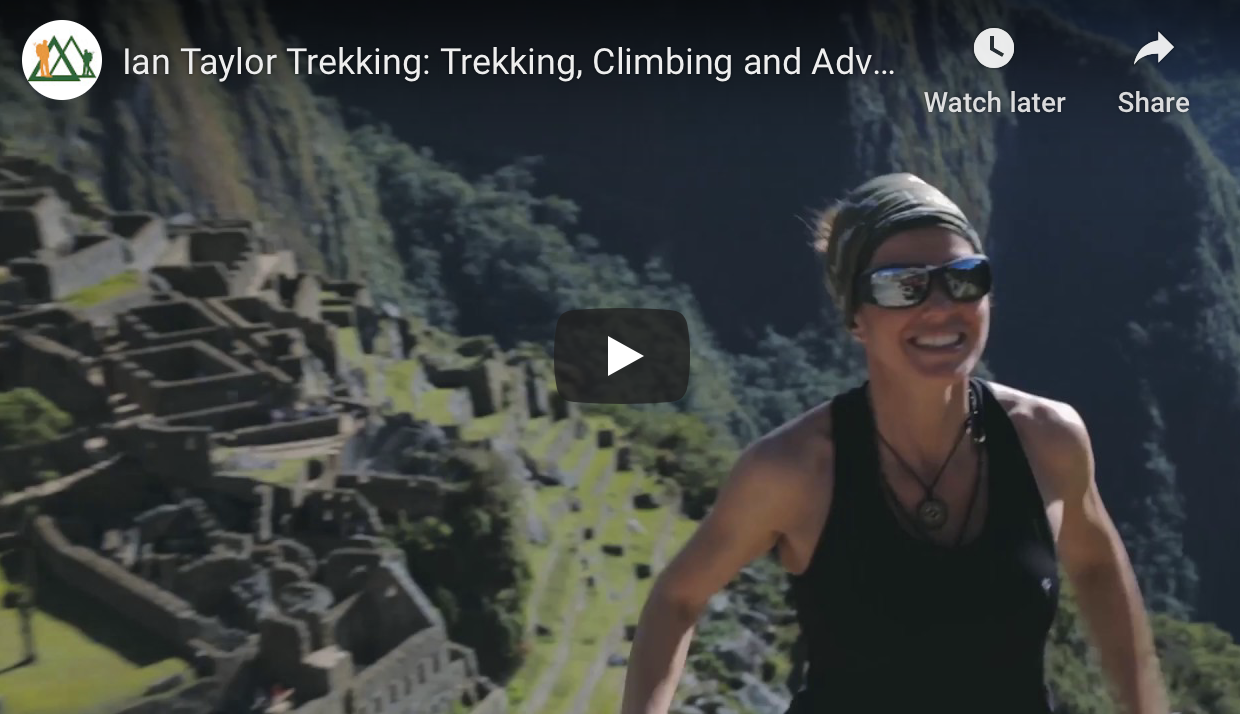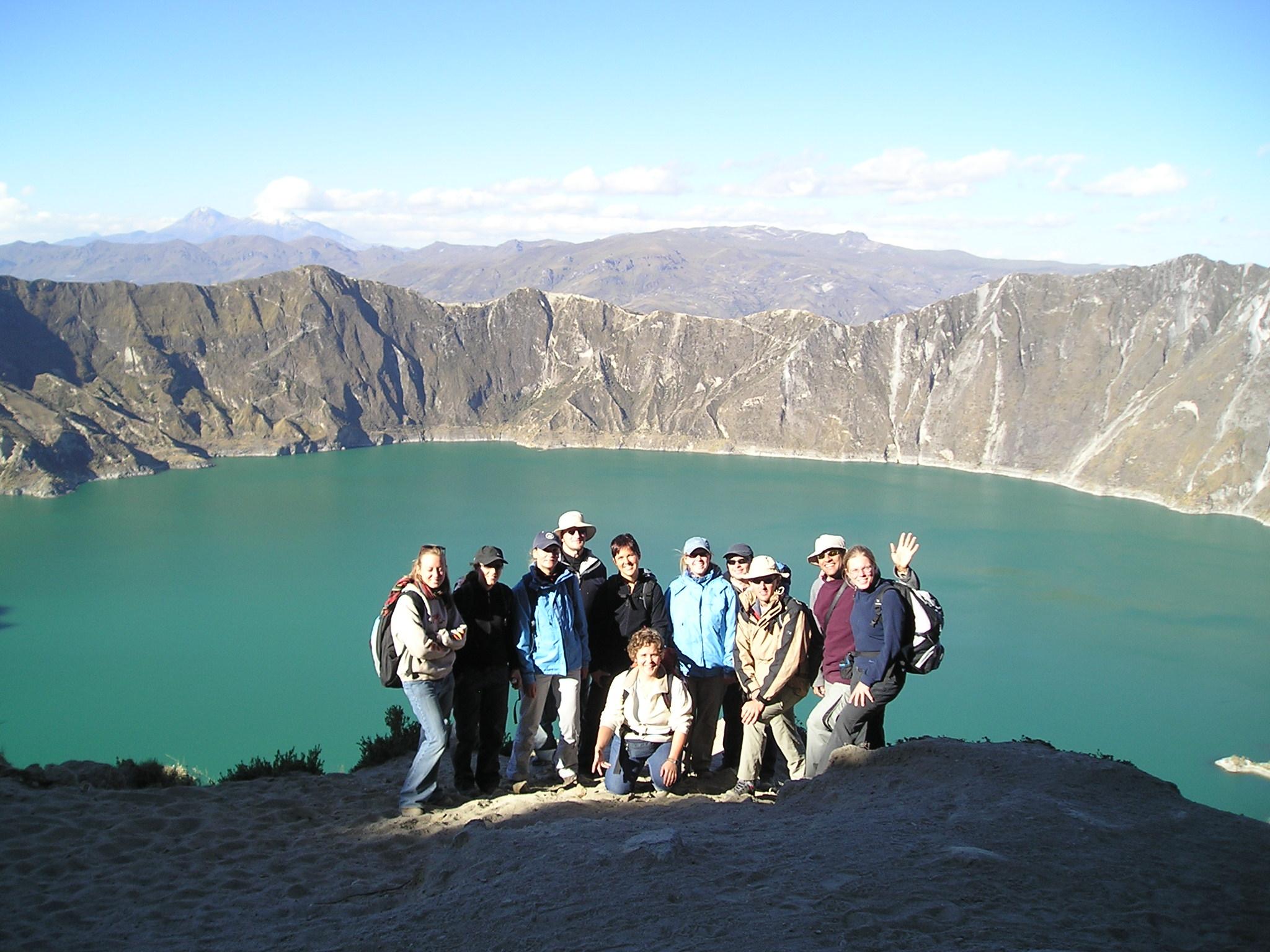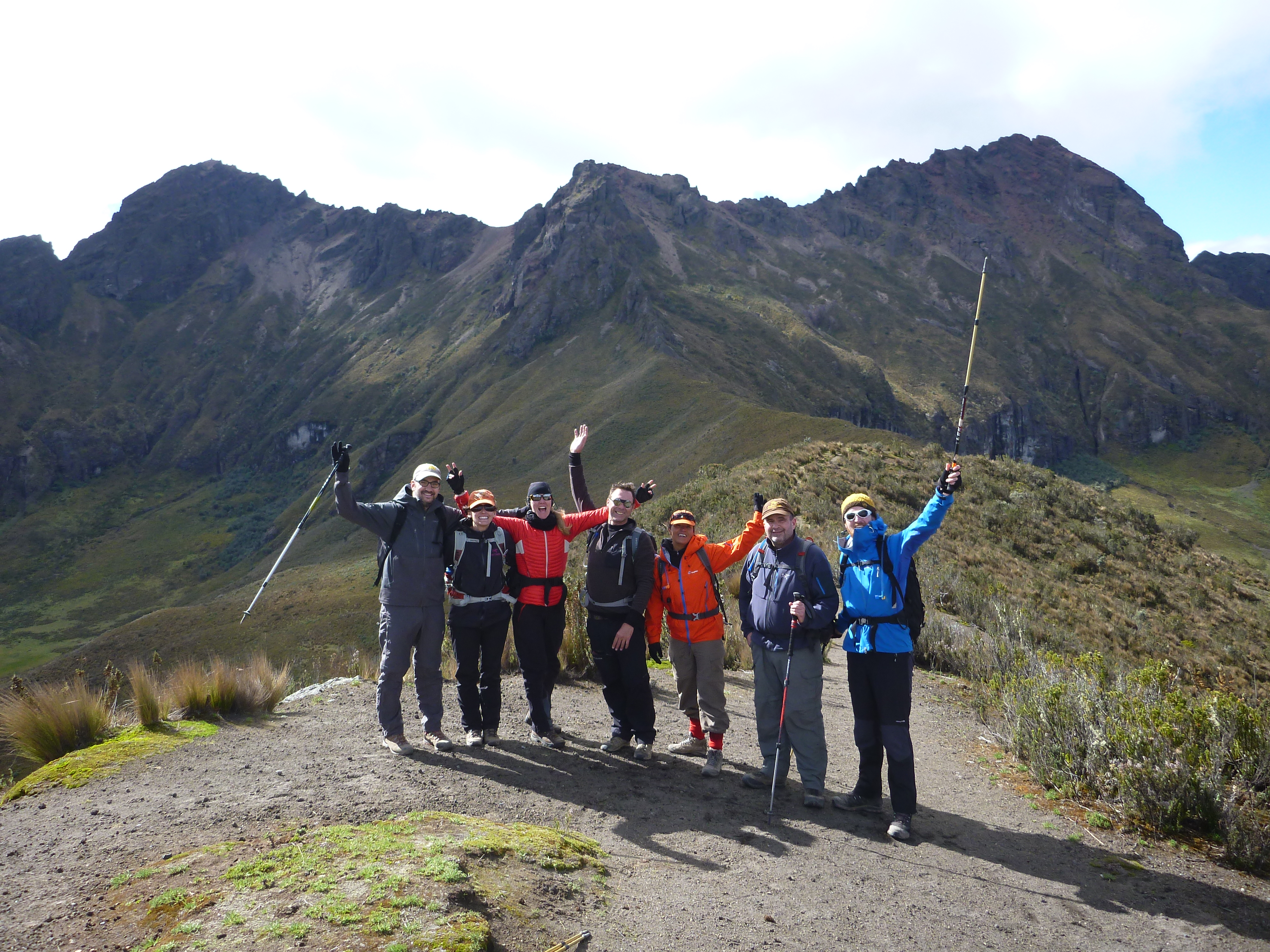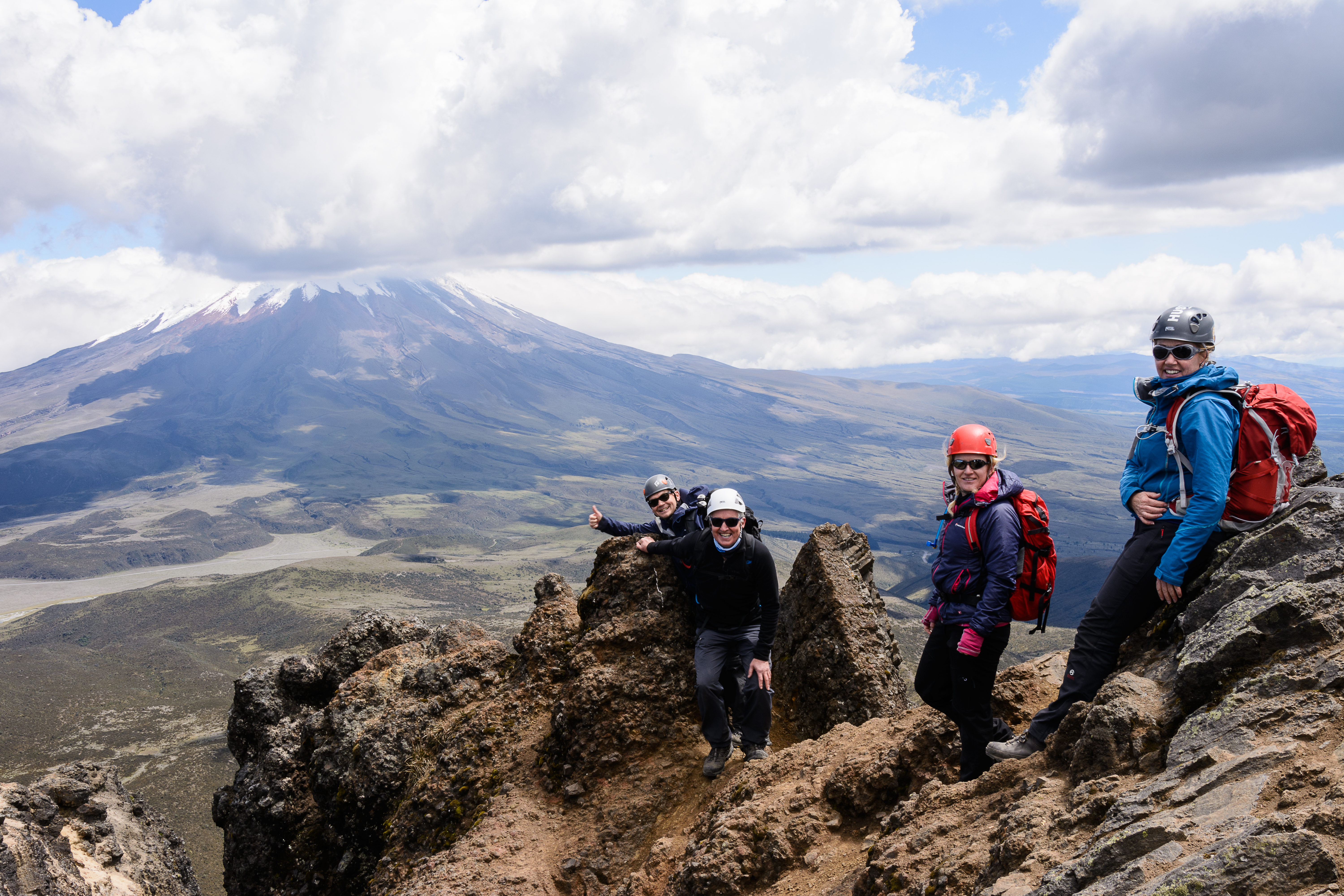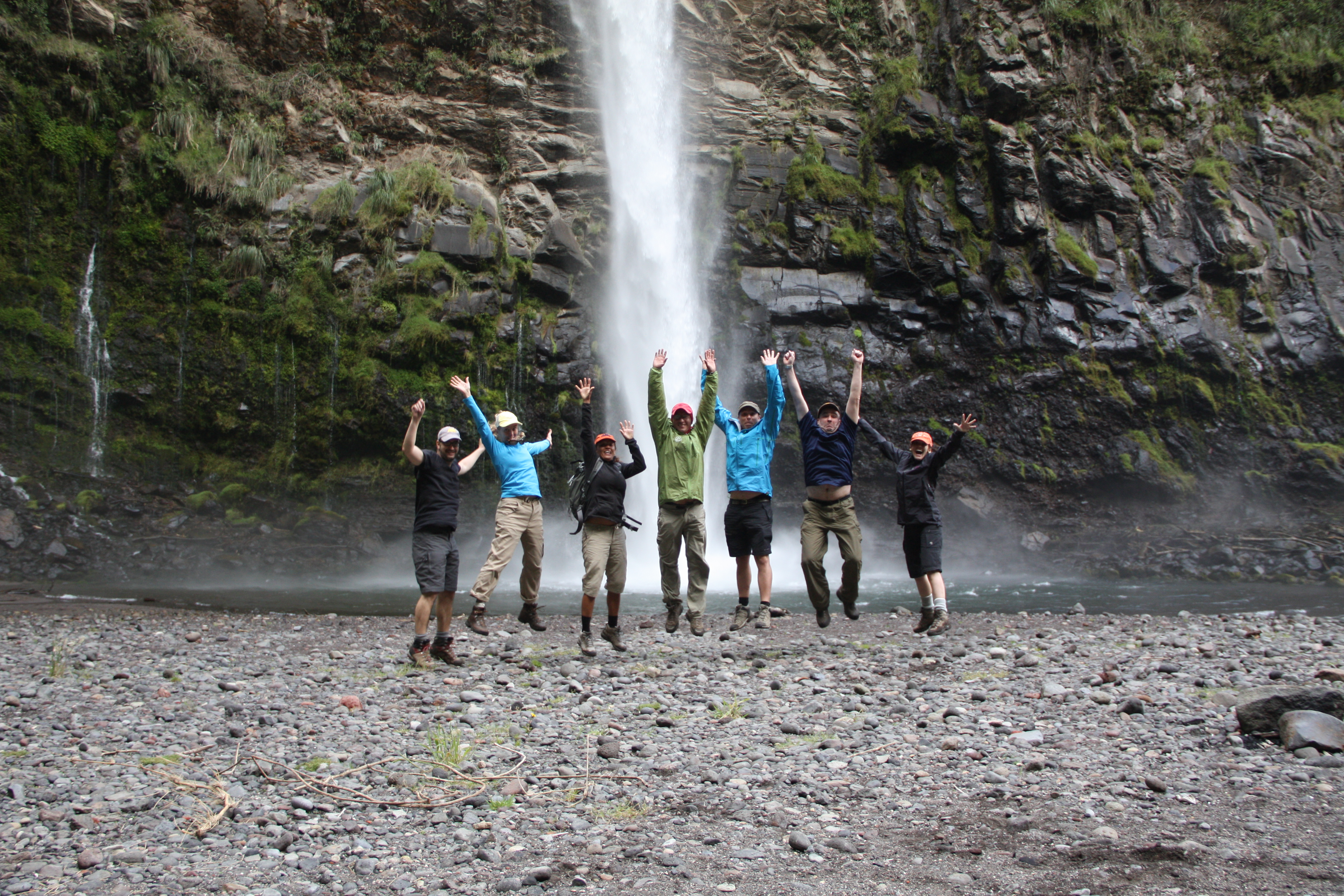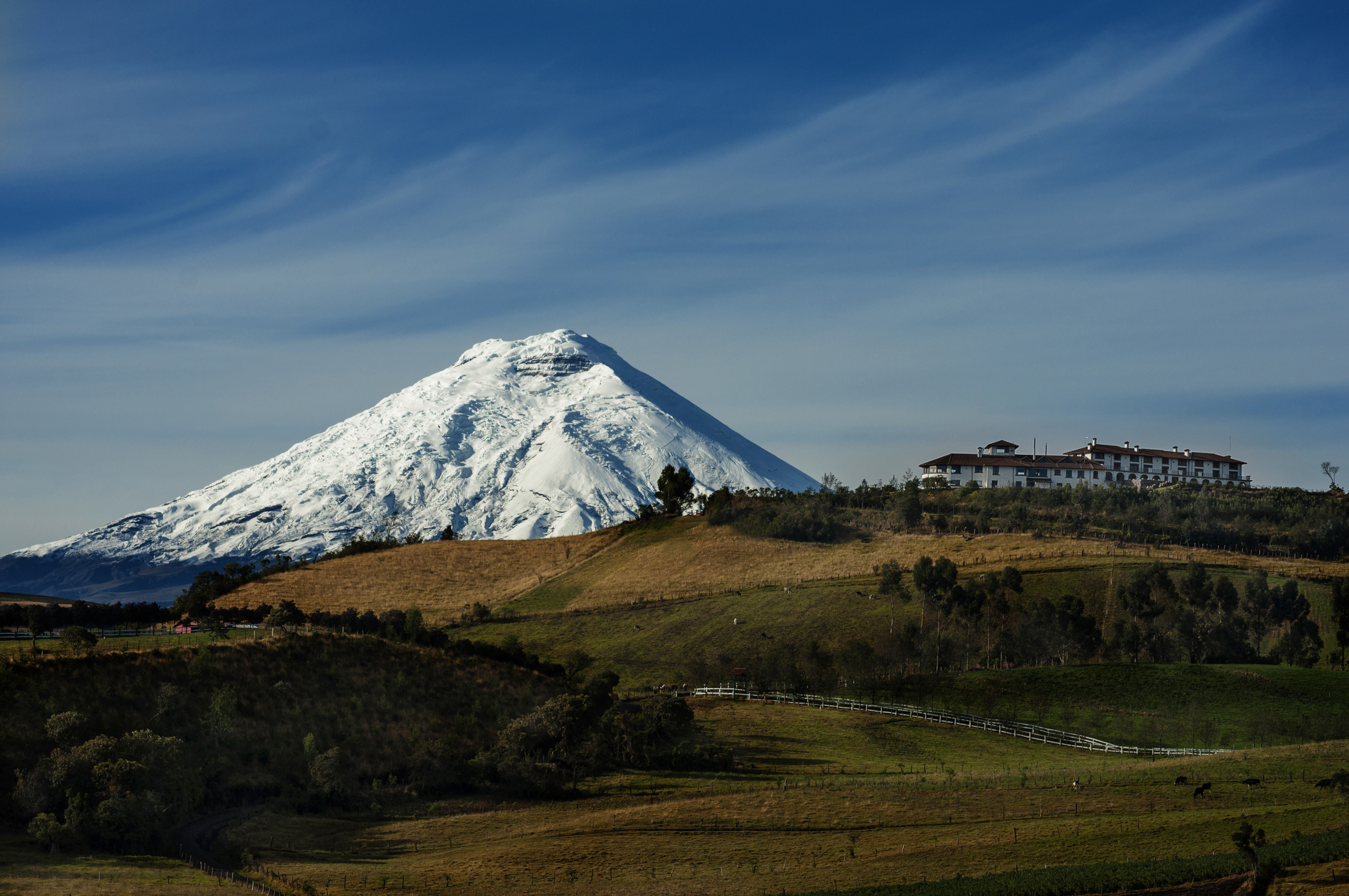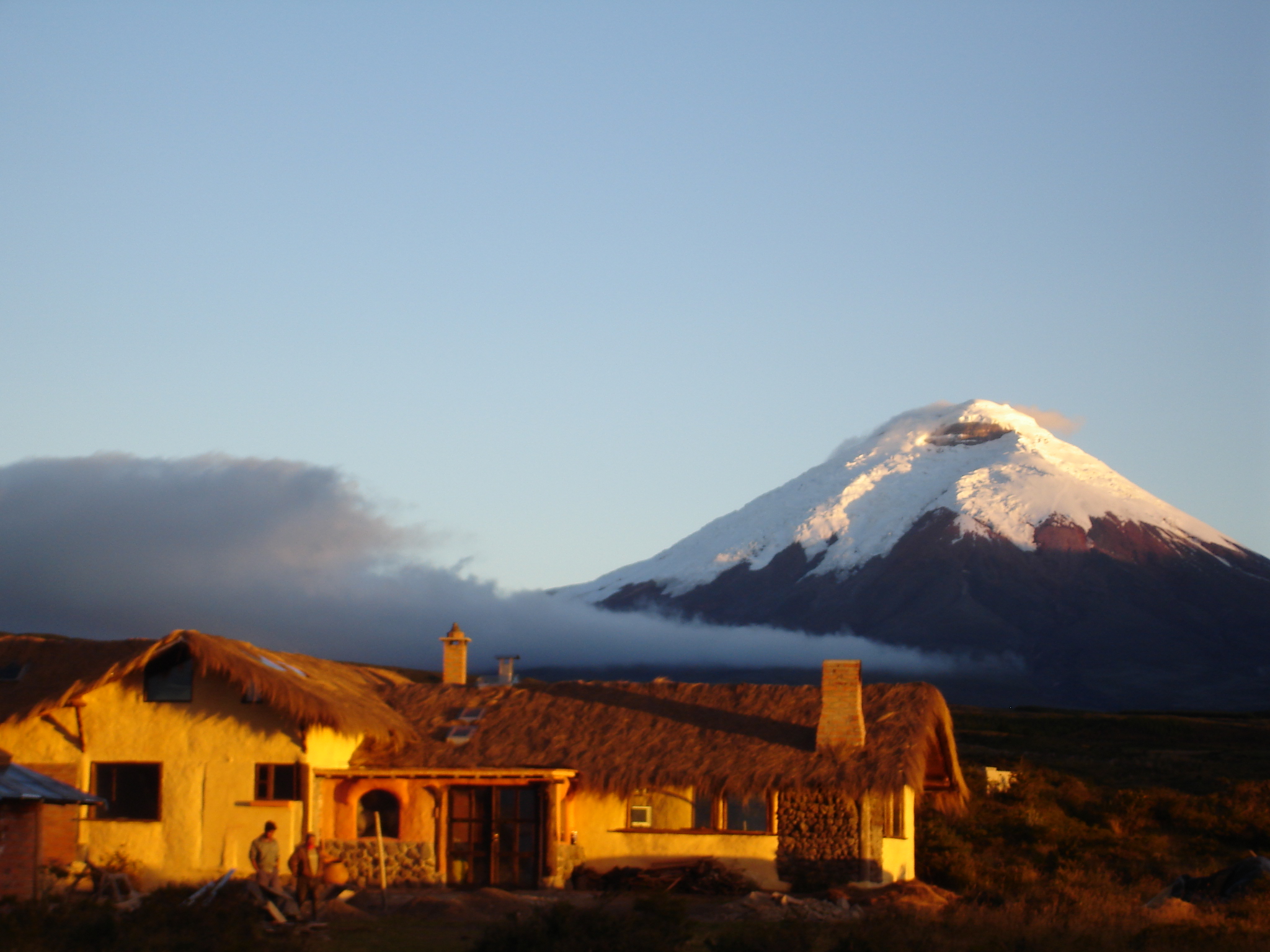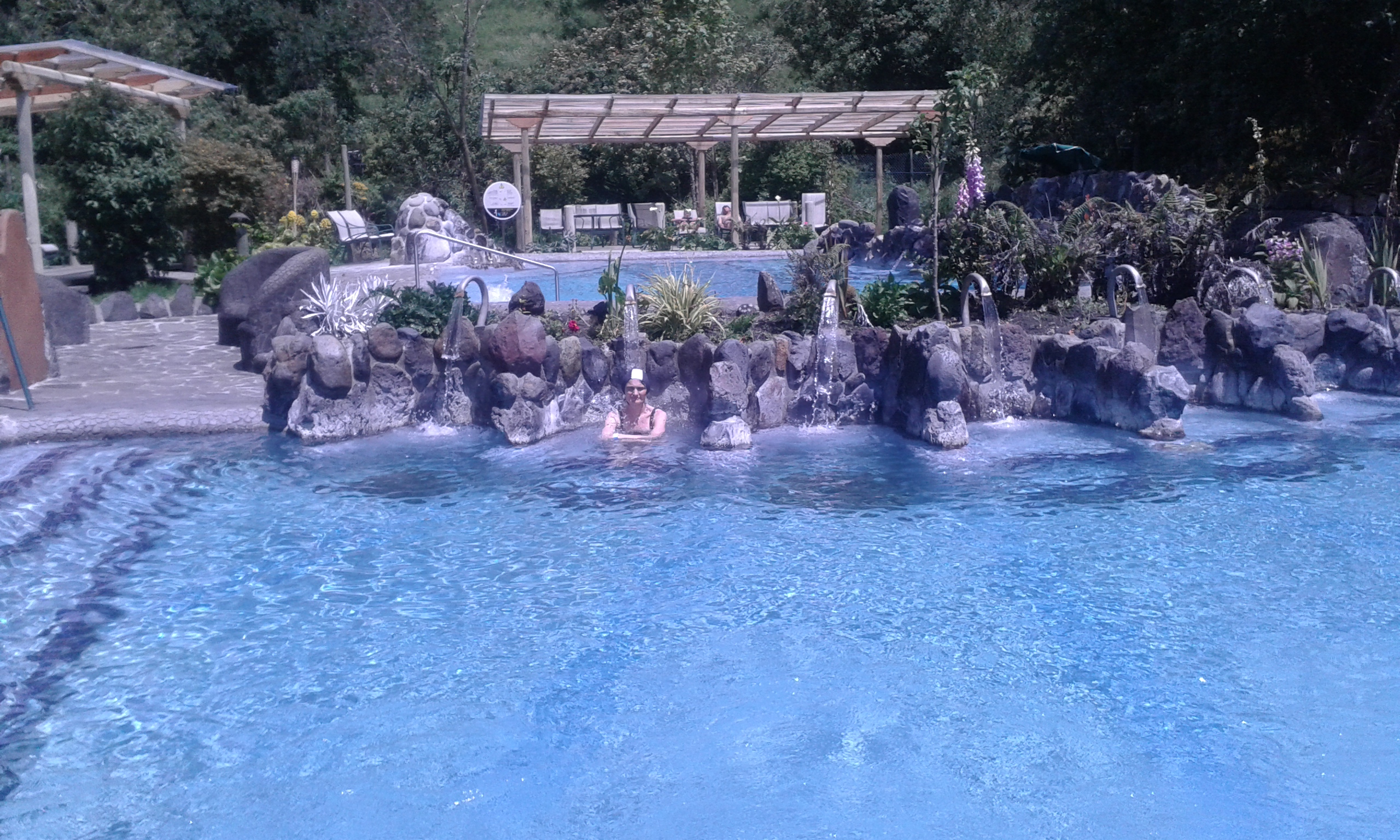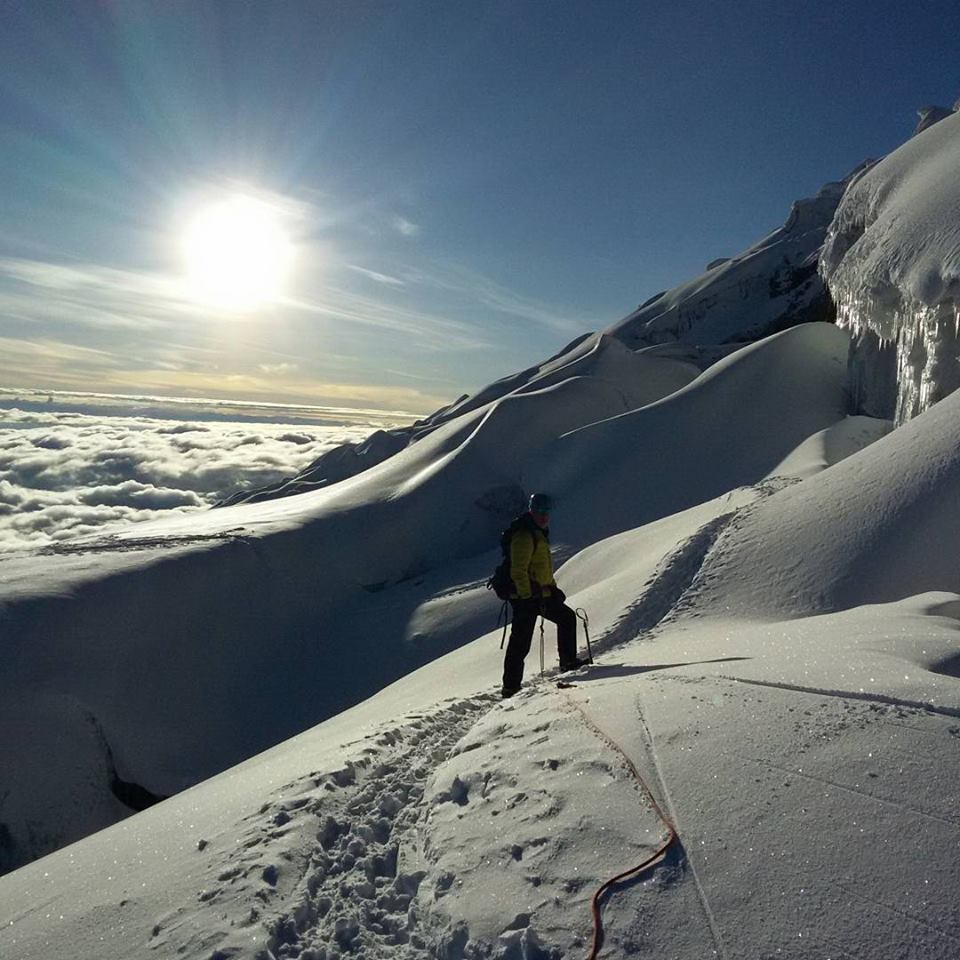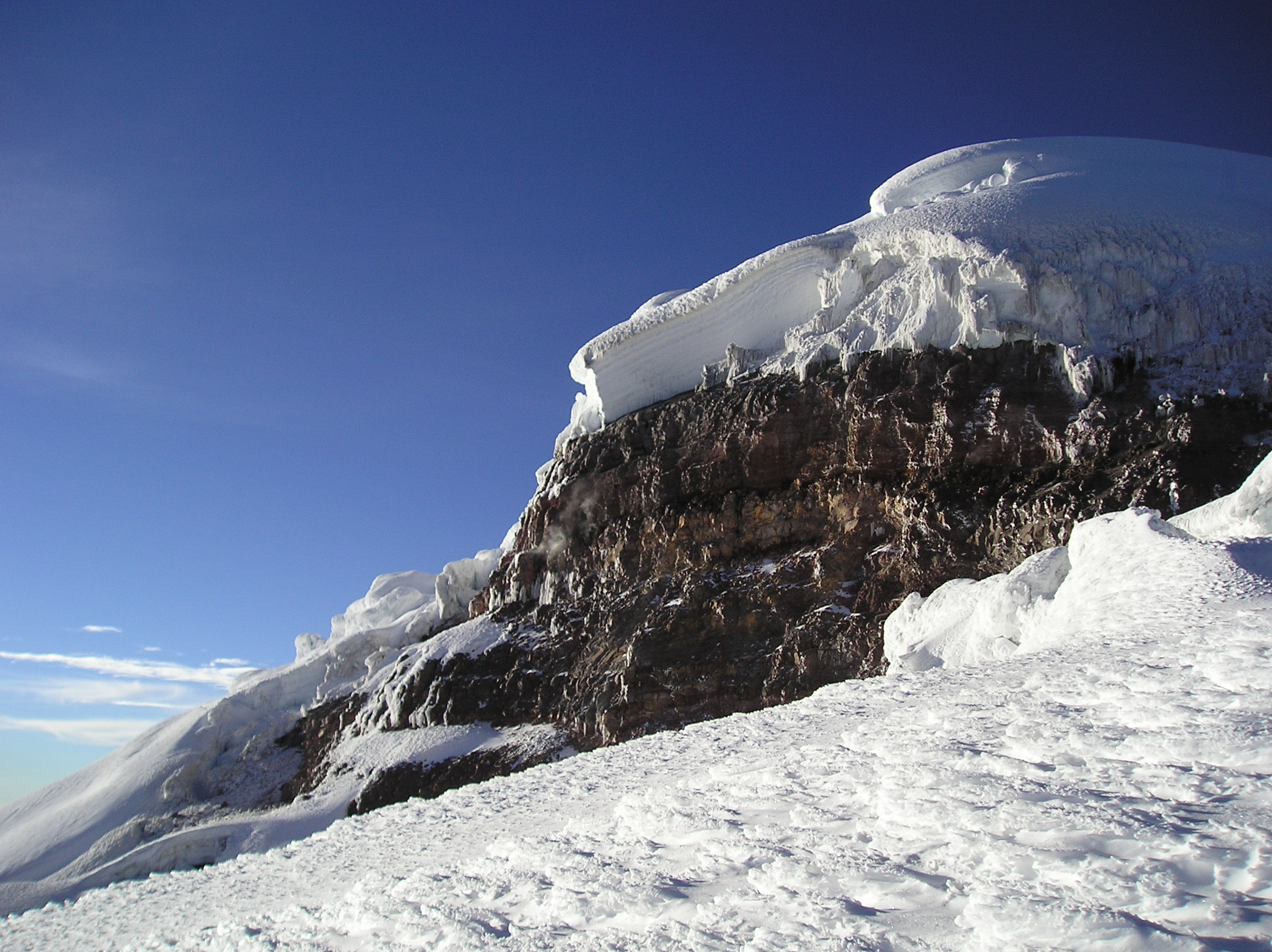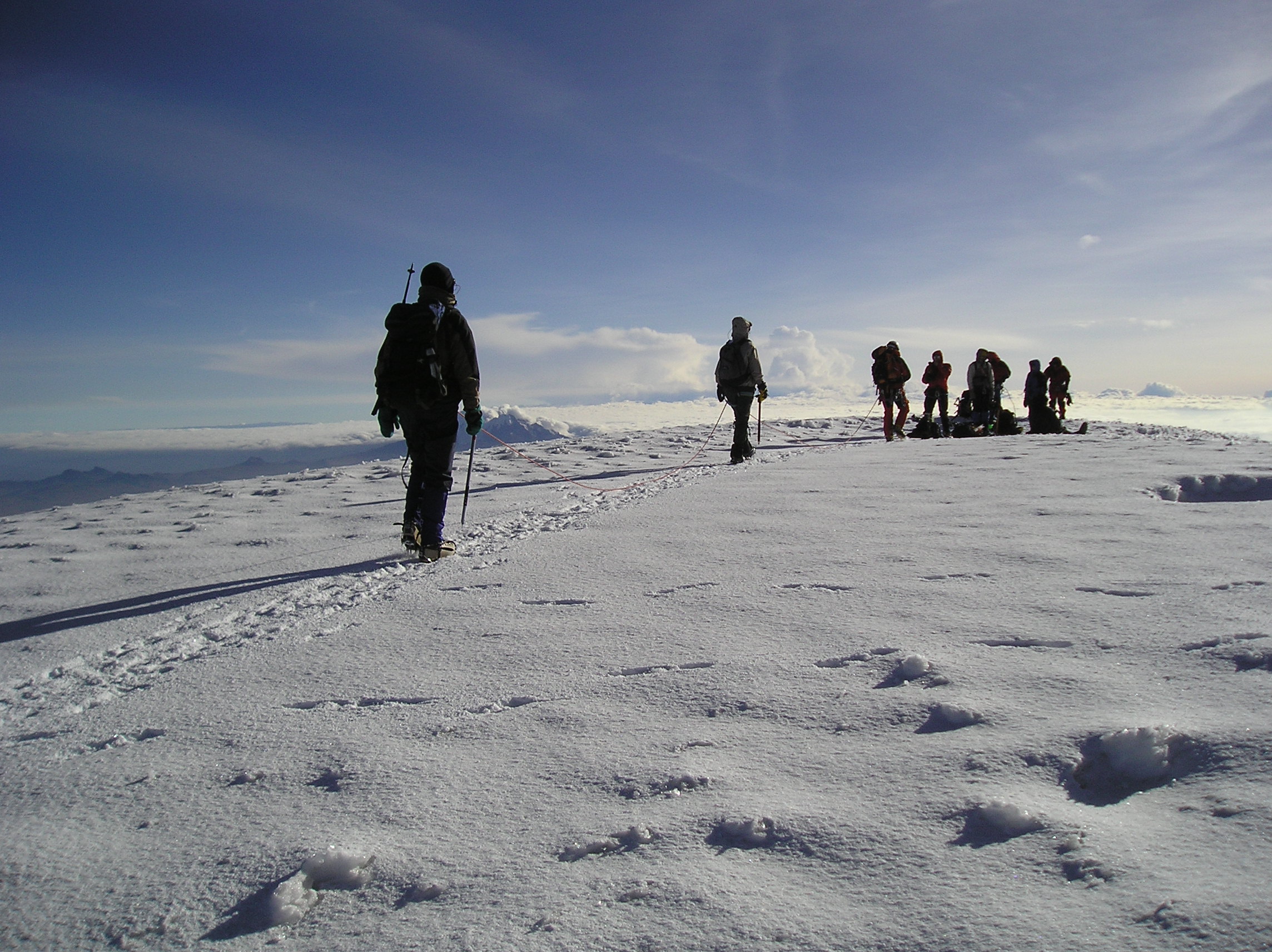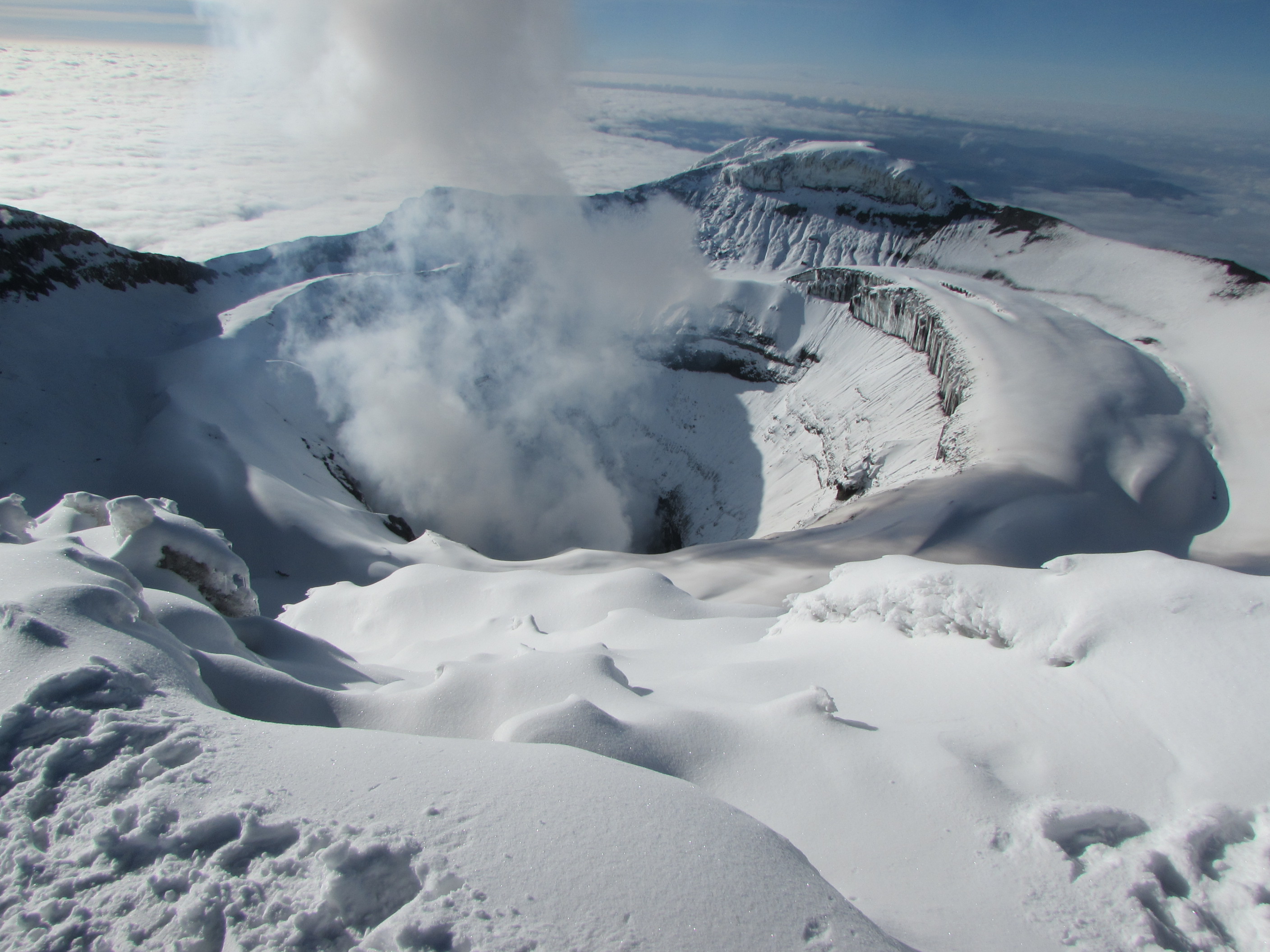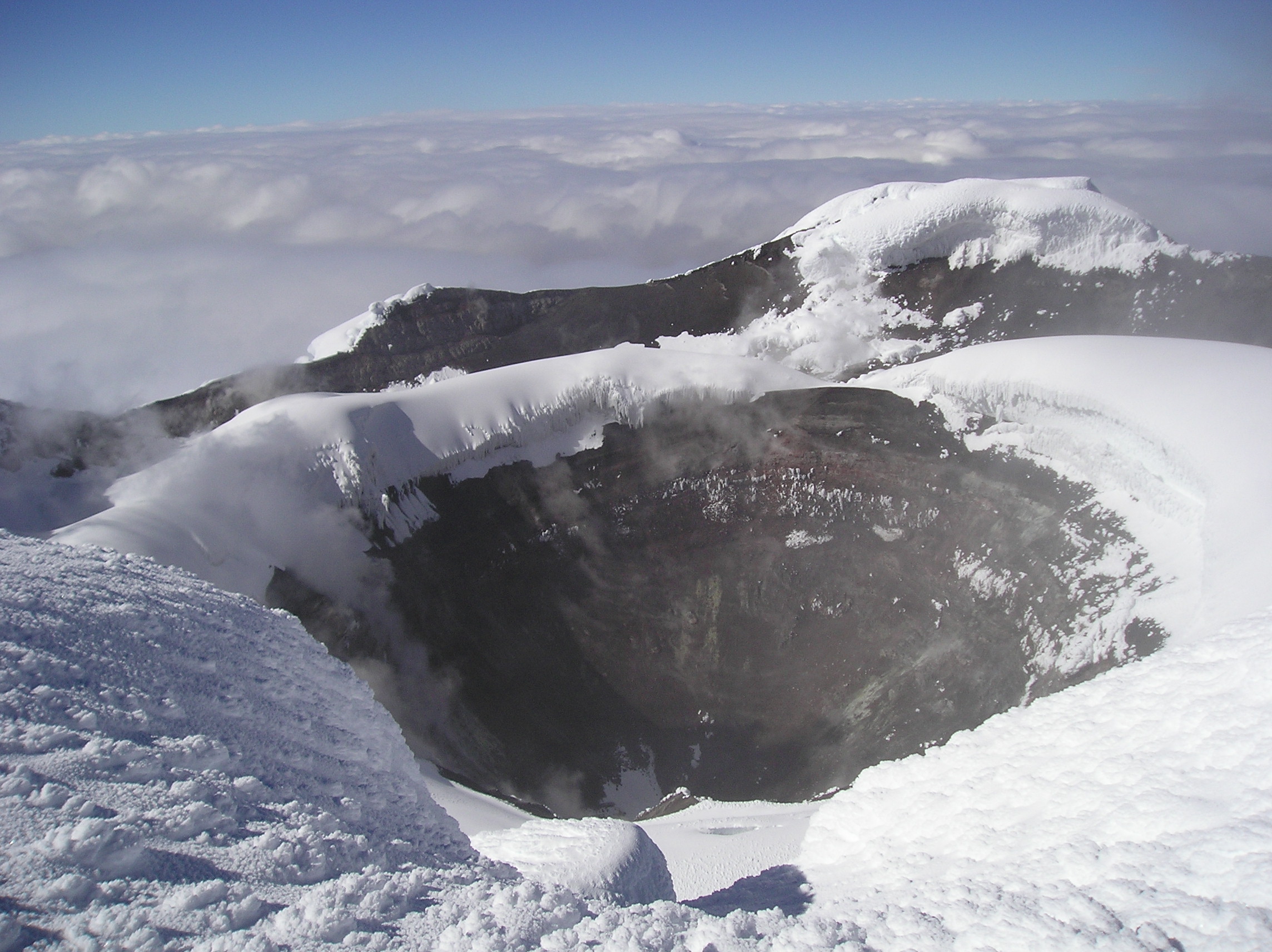Climb Cotopaxi
Our climb begins in Quito 9,350 feet, the capitol of Ecuador. Quito is surrounded by mountains and avenue of volcanos awaits you. We spend a few days exploring Quito’s mix of colonial and modern streets and hiking in the surrounding hills as we acclimatize in preparation for Cotopaxi. This is where we are different. We will head to Cotopaxi and ascend using a network of lodges ending up at 17,000 feet for our final ascent.
Ian Taylor Trekking have been running trips to this region for a decade and developed unique itineraries with acclimatization and safety at the forefront of the trip. We always have more guides on all our mountaineering trips and only run high quality adventure trips. Prices start from USD $3,250.
Tips and Advice
Cotopaxi volcano attracts climbers from around the world. It is easily accessible from the United States and we have been leading trips there for a decade now. We have decided to offer our top 20 tips for a safe, successful and enjoyable experience. Contact us and learn more about our next trips to Cotopaxi.
What is the Best Route to the Summit
Cotopaxi is a very active volcano and was closed to climbers in 2015 following eruptive activity. Thankfully, in 2017 it was re-opened we resumed running trips to Cotopaxi.
Reaching the Cotopaxi summit requires excellent acclimatization. After careful consideration we only run trips that have 9 days of acclimatization before any summit attempt.
1). Acclimatization
Without good acclimatization you have nothing. After 20 years of going on and leading trips. There is one thing that needs your highest consideration and that is the itinerary and the approach to high altitude. We always have additional acclimatization built into all our itineraries. Check out our itinerary and the best route to climb Cotopaxi. Acclimatization is a critical component for safety and success on any high and extreme altitude expedition.
2). Training for Cotopaxi
Can you carry a 12kg/ 26lbs pack for 4 to 6 hours at sea level? Can you carry 12kg/ 26lbs pack up and down 1,000m/ 3,000 feet back to back? You do not need to carry this weight in every training session but important to build slowly over months of preparation. You also need to supplement longer hikes, training sessions with daily training focused on building strength and endurance.
We can not emphasize how important your physical preparation is for this challenging trip at high and extreme altitude. We have climbed Cotopaxi and Chimborazo many times and always happy to help you develop the training plan. Do not underestimate the training needed to be safe and successful on Cotopaxi.
3). When Is The Best Time To Climb Cotopaxi?
Ecuador has a great climate that allows year round climbing on Cotopaxi and surrounding volcanos. Climbing to the summit can be done at any time of the year. Cotopaxi has the highest number of clear days in the Ecuadorian Andes. June and July are the dries months, but it can be extremely windy. Two of the best months to climb are December and January and less windy than the June and July timeframe. Alternatively, August and September are also good months to climb but expect to have a lot of wind.
4). Bring the Right Equipment
On any Cotopaxi expedition, you have to make numerous ascents up and down the mountains in a wide range of terrain and conditions. One reason for this is to help the body adjust to the lower levels of oxygen as we move higher. Make sure you have all items on the gear list and know how to use them. Having lightweight clothing and equipment will make a difference in how much weight you are carrying. Also, practice using your gear and equipment and make sure it fits comfortably. Having lightweight equipment and clothing means you will have to carry less weight up and down the mountain. Having prepared your gear and using each piece before the trip, helps you become mentally prepared.
5). Get a Fitness Test
Schedule a physical with your doctor to make sure you are in good health before you start training. You should then consider getting a fitness test. The results should indicate your current level of fitness and provide a road map for the way ahead. Use the results to develop a proper training plan, so you are not guessing how your fitness is developing. You need to know at what heart rate your body produces lactic acid in your muscles. Knowing your lactic threshold helps you develop a training plan best suited to your needs. Training in the right heart rate zone and building the right training is important for your safety and success.
6). Understand Altitude Sickness
If you have been on a number of altitude expeditions with us you will know all about altitude related issues and problems. Read and understand the principles of acclimatization and altitude illness. By picking an itinerary with more acclimatization, you give yourself a safer journey into extreme altitude. You also need an itinerary with built in contingency days for bad weather especially if you decide to climb in windy months.
The altitude along with physical fatigue are usually the downfalls of many climbers on Cotopaxi. A lot of climbers get altitude sickness and struggle with the physical effort high on Cotopaxi. The sad thing is you can control both of these issues by training correctly and picking an itinerary with the best acclimatization.
7). You Should Consider Taking Diamox
If you are taking prescription drugs, make sure you bring a sufficient supply to last more than the length of your trip. We highly recommend taking Diamox for the duration of the trip. Our high altitude specialist doctor recommends 125mg in the morning and 125mg in the afternoon. Make sure your Diamox is in tablet form. You will also need to bring a number of antibiotics. There are alternatives to taking Diamox and you most certainly should bring ibuprofen on this trip. Ibuprofen will aid with sleeping at high altitude.
8). Be Upfront With Your Medical History
Make sure our guides and staff are informed of any previous conditions or medical situation you may have. Don’t keep any issues to yourself, altitude sickness can kill. We implement a slow pace for all trekking and acclimatization days on the trip, however, you can still have altitude related issues. Make sure that your guide knows your medical history.
9). Conserve Energy Early in the Trip
The pace of your trip is critical to recovery each day on a multi-day adventure. Moving too quickly at altitude often leads to altitude illness and does not aid in your recovery. Fatigue is not your friend on a multi day trekking expedition. Good recovery is critical for a safe and successful trip. A slow pace and slow movement to high and extreme altitude is very important.
10). Hydration, Hydration, Hydration
One of the most important tips we will give you is to make hydration a priority. Hydration at high altitude is extremely important. When you wake up you need to drink 1 liter of water before breakfast. You need to drink 2 liters before lunch and another 1 to 2 liters in the early afternoon. Using a water bladder system is ideal because you can then drip feed water into your body on a regular basis. This will be used on the trek in and lower on the mountain, however during the summit attempt it can not be used as it will freeze. Forcing water in, is not a good idea as you will just pee it out. You will need hyper hydration sachets, multi-vitamins and electrolytes while on this Cotopaxi trip.
11). Separate all Your Gear into Dry Packs
Manage your gear well and keep all items separated in dry packs. Alternatively, you can keep your clothes in plastic bags. While you are on the mountain you will need to manage your gear. Having a good routine is very important, keeping separate bags for gear is very useful. The dry bags are useful to keep your gear organized when you do gear drops up the mountain.
12). Make Sure you Eat as Much as Possible
We always have quality food on our trips and this is critical to your expedition. Sometimes at altitude, your appetite can dwindle, but you need to try and finish every meal. It will give you the strength and energy for each day on the trip. You do not want to over pack snacks as you have to carry everything up and down the mountain. You should have some recovery and protein bars in your duffel bag.
13). Bring a Lightweight Sleeping Bag
You need to have a lightweight warm sleeping bag. We recommend a 0 or 10 degree Fahrenheit sleeping bag or similar Cotopaxi. You need to be comfortable throughout the whole trip. Sleep is a key ingredient to acclimatization and essential for success. Also, make sure that you have tested out your sleeping bag.
14). Come With a Climbing Partner
Working as a unit and team is important in achieving the groups goals. High on the mountain you will be roped to a guide and one other climber. Climbing with someone of the same ability is really important for safety and success. Communicate with the guides if you are having problems. They can only help if they know that you are struggling. Cotopaxi requires you to be a team player and maintaining a positive mental attitude at all times throughout the expedition. Encourage others and others will encourage you. We are much stronger as a group, not as individuals.
15). Bring Multi-Vitamins
We recommend taking multi-vitamins on a daily basis before and during the trip. These can either be the type that we dissolve in our water or as a tablet to take daily. You need to consider a range of supplements to maintain a strong immune system. Bring hydration tablets for your water to take daily. If you sign up with Ian Taylor Trekking for your Cotopaxi expedition, we will send you a trip Dossier, that includes a complete kit-list for the trip.
16). Only Bring Essentials
Have a small medical kit that is easy accessible while climbing. This medical kit should have Ibuprofen, blisters plasters, tape, sunscreen, lip protection, medication, plasters and personal items. Also, make sure you have your personal medication you take with you at all times. You need to streamline your medical kit, in the same way you would on any trekking and mountaineering trips.
17). Come With the Correct Mental Training
Having the experience in harsh weather conditions, will be essential in your preparations. Also carry a weighted backpack in your training, in order to be physically ready for the summit. Mentally prepared for your Cotopaxi experience, for example, pushing the limit in your training sessions helps. Additionally, the more comfortable you are in a mountain environment, the more mentally prepared you will be. Staying positive with a good mental attitude on the mountain, is important for you and the people around you. High on Cotopaxi is a mental and physical challenge. Staying positive in the face of harsh, challenging conditions is needed to be successful. Mental preparation starts at home in the hard training you do before the climb.
18). Expect Harsh Weather Conditions
Be ready to cope with diverse weather conditions. You may experience drastic changes in the weather from warm/dry conditions to freezing and windy weather. High winds are usually the biggest challenge on Cotopaxi, similarly freezing temperatures can cause you pain and discomfort. Understanding that some factors are beyond your control, and weather being a big one of these. Focus on the elements of the trip you can control, for instance you can come with the right attitude, gear and physical preparation.
19). Know Your Limits
Know your limit on any mountain. One of the ways to achieve this is to hit the wall in your training at home. Remember your safety and the safety of others should be your number one concern on the mountain. Make sure that you have pushed yourself hard in your training and have prepared correctly before stepping foot onto the mountain. While you are on Cotopaxi, don’t push yourself to the point of putting your life or the life of others in danger.
20). Respect the Team and the Mountain
Respect other climbers. You are climbing as a part of a team and therefore, you have to be aware that timelines have to be kept and differences have to be accepted. An expedition can be a multicultural experience with people joining our trips from all over the world. That means different cultural backgrounds with different religious ideals or philosophies. Everyone in your expedition is struggling to reach the same goal, so respect the team. If you see your team member struggling on any given day, be there to help them. It could be you the next day that needs the extra support! Team work and relaxed attitude will be valuable assets on a trip like this, finally respect the mountain and extreme altitude.
Ian Taylor Trekking have extensive experience managing trekking and mountaineering trips in Ecuador for over a decade. Ian has climbed Everest and led over 150 expeditions above 17,000 feet and Ian is available to help you be successful. We know what it takes to run safe, enjoyable and successful expeditions in Ecuador.
1). IFMGA Mountain Guides
Our mountain guides are qualified professionals with years of mountaineering experience in Ecuador. We believe that to succeed in our expeditions, professionals with experience and the ability to offer the highest level of safety is everything. All of our guides hold professional IFMGA or AMGA mountaineering qualifications and wilderness First Aid Certificates. They can manage any emergency that could arise. We want to make sure all of our teams have the best chance at safely reaching their goal. With more guides with your team, they will be able to more efficiently manage your safety on the mountain and also give you a better experience along the way. We have 1:2 guiding ration on Cotopaxi and Chimborazo.
2). Acclimatization
Over years of running trips to Cotopaxi we have changed our itinerary to offer you the best experience in Ecuador. We know that acclimatization is the key to everything on a high altitude adventure. That is why we have designed this itinerary, with optimal acclimatization so you can have the best possible experience.
3). Expert Training Advice
We offer personal service with training advice for our clients, 5 days a week. A lot of people underestimate the physical preparation needed to climb Cotopaxi. Please do not show up under prepared as you will be roped to another climber and this can ruin someone else’s trip.
We want to make sure that you have the best information on how to complete this adventure safely and successfully. There are some long 8+ hour days, with over 1,000m/ 3,280 feet of up and down hills on steep terrain while on mountain trails and glaciers. We look forward to speaking with you about preparing for this trip. We also provide you with a trip dossier with a lot more information on how to prepare for the trip.
4). Check out our Top 20 Tips
After years of leading and running mountaineering trips here are our top 20 tips for climbing Cotopaxi.
5). We Climb in the Best Months
Although Cotopaxi has clear weather year round, there are definitely some better months than others. Rain is common on Cotopaxi from March to May and again from September to November. Rain means less chance of observing the volcano at it best, so it’s best to avoid visiting during these months.
The busy months are January to May. We like to run trip to Cotopaxi from November through March. June to November is considered the quiet season for tourists, so this can be a great time to visit. Keep in mind, that from September to November the weather may be wet and can make summit attempts more challenging.
6). Our Itemized Kit List
We have developed an extensive itemized kit list for you. Making it simple, clear as easy to come fully prepared with the right gear, clothing and mountaineering equipment.
7). Quality Hotels and Equipment
In Quito we use the Reina Isabel in Quito. This hotel is centrally located. On the mountain we use the best lodges available in the region.
8). Small Group Sizes
We only work with small group sizes. The maximum number of people per team will be 12 people. Some of our groups are even less people with only 6 or 8 team members. We also run private groups trips to Cotopaxi. This will therefore give you are more personalized experience.
We believe the journey is far more valuable than the destination. Building a team throughout our program so you can acclimatize well and experience the best of this region of the world. Our guides will monitor your heart rate and oxygen saturation morning and night to make sure you are acclimatizing correctly to the lack of oxygen.
9). All Inclusive Packages
We will pick you up from the airport and transfer you to the Hotel in Quito. Our staff will process all the permits and park fees. All transport will be in high quality private vehicles. All of our trips include city tours and the best mountain guides and service throughout.
On the mountain portion of the trip we serve 3 meals a day. Therefore, you do not have to worry about bringing extra food. We can guarantee quality food throughout the trek.
10). Expert Office Support in Colorado
We have highly experienced team members available 5 days a week in support of your trip. They have all climbed Cotopaxi numerous times, and always happy to chat and answer any questions you may have. Get in touch and learn from our experience.
Preparation and Training
After climbing Mount Everest, leading 40+ Kilimanjaro climbs and 5 Cotopaxi and Chimborazo climbs I know what it takes to reach the top. Depending on your hiking and glacier experience this trip maybe be easier for some people and much harder for others. The keys to success are in acclimatization along with building up to long distance hill walking 5+ hour hikes carrying weight once a week. It is important to supplement the longer hikes with daily training that focus on building strength and endurance.
Are you a Hiker?
When deciding to climb Cotopaxi, you need to consider your current ability, access to training facilities, and how much time you have to dedicate to training. All of these things will determine if you are successful on the climb. If you think running and walking on the flat with a weighted backpack are enough, you need to think again. Leg strength and endurance training are important for safety and success.
Plain and simple, spend more days acclimatizing on the mountain and build up specific physical training. This will give you the best chance at safely reaching the summit and getting back down again without guides having to carry your backpack. These are the two main reasons why people are not successful reaching the summit of Cotopaxi. We can help your understand this specific training.
The Two Main Factors
Firstly, In my opinion you need a nine day itinerary for Cotopaxi. Taking nine days will give you the best acclimatization process and the best experience possible. Climbing Cotopaxi is truly one of the great mountain experiences. So why not spend more days on the mountain to get the most out of your experience. I know it costs more, but you will come away with a much richer experience.
Secondly, you need to make sure that you are coming with the right training and preparations. We are available 5 days a week, to make sure you are getting the best information on the climb. We want to make sure that you have the tools to be safe and successful.
All of the factors below will assist you in making sure you are coming with the right information! Check out our Top 20 Tips.
Consider The Following
When you think about these elevation gains and long steep descents you need to review the daily distances, elevations gains up and down. Consider the incline on ascent and descent and think how you train for low oxygen environments. We can help you understand the key elements to this and how you can map out a training plan for climbing Cotopaxi.
Hiking up and Down Hills is the Best Training
Hiking up and down hills with weight is by far the best training you can do. Try to build up from 3 hour to 8 hour hikes once a week. Taking regular and increasingly longer hikes will help develop the muscles that you need when you arrive on the side of Cotopaxi. This can not be on the flat. You need to trying to gain 500m/ 1,640 feet, building up to 1,000m/ 3,280 feet ascents and descents. However, very few people are lucky enough to have access to hills every weekend. Try to find some local hills or stairs to walk up and down if possible. Gradually increasing the duration of your walks will help to develop your stamina and also assist in preparing you for being on your feet over long distances.
When out on training hikes, ensure that you always wear the trekking boots you intend to take to Cotopaxi and try and ease your way into the Mountaineering boots. It is also good to train in the same backpack you will be taking with you on the climb. This will help you feel at ease with it and gradually add weight to the pack to build strength. Building up gradually from 6kg/ 13lbs to 12kg/ 26lbs over a 6 month period.
Talk to the Experts
Before you travel to Ecuador, we will be here to answer all of your questions. We want you to have access to the right information.
Make Sure you Have the Right Physical Conditioning
Despite being a mountain which is accessible to most people and not just experienced trekkers, you must prepare. This is important to understand! If you are used to hiking up and down hills with a weighted backpack, while covering long distances in difficult terrain, then you have less training to do. However, if you are older or not used to hiking, but consider yourself to have good overall fitness, then you will have more specific training to do. Cotopaxi is a long slog, so you need to be doing more specific training geared towards hills and stairs, building your muscle memory by carrying a weighted backpack.
Giving yourself enough time to train for a trip like this is essential. If you are only have limited training/experience with hiking, you will want to make sure you give yourself ample time to prepare. You never want to jump into the specific training right away if you do not have a good base level of fitness already. Get in touch today and we can talk through where you are and where you need to be for the climb.
Don’t Underestimate the Climb
Cotopaxi should not be underestimated. Especially the the summit night. Hiking to its summit is a serious challenge which requires significant preparation and specific physical conditioning. Leg strength and endurance training are both the key to success. With forward planning, the right acclimatization schedule and the right attitude to training, you will give yourself the best chance of success. The goal is to reach the summit, however the entire journey, up and down the mountain, is only going to be enjoyable and possible if you have put in the right preparations.
Specific Training
Climbing Cotopaxi is a physical challenge which is well within the reach of most people. However, you must be willing to do the specific training. I have climbed Cotopaxi many times and I still train 4 or 5 times a week. I also always have a weighted backpack to maintain leg strength and endurance which are both key to success. This specific training is absolutely necessary for success no matter your level of fitness. We strongly advise you to seek medical advice before starting a training program. Particularly if you have concerns about your health or are getting older.
Focusing on Summit Night
Remember the summit day is 10+ hours. From our high point at 4,800m/ 15,748 feet, you have ascend 1,097m/ 3,599 feet into extreme altitude to reach the summit. Then you also have to drop 1,097m/ 3,599 feet. This requires serious preparation.
It is important to start training as early as possible before your scheduled climb. Building strength, fitness and stamina. The best physical preparation is activity which simulates, as far as possible, the demands on your body that you will have during your climb of Cotopaxi. In my opinion there is no better way to building endurance than by walking up and down hills with a weighted backpack. Doing this while building up weight in your backpack is key to success. If you do not have access to hills you need to be using a stair master or incline treadmill to gain the required strength and endurance.
Some Additional Information
I am just back from Cotopaxi and one thing that stays the same for me, is you need as much time to acclimatize as possible. We have a 95% success on the 9 day trip. I can not emphasize how important the extra day is in terms of your safety, enjoyment and your success.
Mentally Prepare for the Climb
Being mentally prepared will also be crucial to your chance of a successful summit climb. Progressively pushing the limits of your physical training will help develop your capacity to endure the stress and strain on your body. Get used to your gear and clothing.
Having a positive attitude is also extremely important when taking on a challenge like this, so be prepared for all aspects of the trip. It is helpful to remind yourself that thousands of people have achieved this feat before you, and you can do it too. But do be prepared for setbacks and difficult stages during the climb as you try to adapt to the lack of oxygen. Remember that our guides, who are the best, will be there to encourage and inspire you every step of the way!
Multi-Day Training
Getting multi-day training or hiking prior to your Cotopaxi climb is extremely important. Training once a week in the hills is simply not enough. You will be walking for many hours at a time, on a multi-day basis. You will also need to train with your backpack. Your backpack will have two or three liters of water, spare layer, rain gear, snacks, camera, medical kit, valuables and sun cream in it each day. Being used to carry double this amount of weight at home is essential for when you are on Cotopaxi.
If you haven’t been training with double the weight you will carry on the trek, on a multi-day basis you are going to get sore legs, back and shoulders. You need to get out and train in the hills. Even better if you can do back to back days to aid in the strength/endurance training. These back to back hikes along with daily training sessions in the gym, will help to push your fitness level to where it needs to be for the climb.
Make Sure you Come Prepared
You have invested a lot of money to do this climb. You have bought all the gear, paid for the trip and bought plane tickets. There is no point in doing all of that and not putting in the efforts in your training. You have also signed up to a group climb and you need to consider the group and don’t show up unprepared. We don’t want to have to turn you around because you couldn’t find the time to train. You need to respect the mountains, the team you are going with and our team on the ground. So come prepared and make sure you find the time to train and make sure it is the correct training. We can help!
Give Yourself Enough Time to Build Specific Conditioning
It is no good trying to cram all of your training into the month before you depart. Put your training plan together months in advance, in order to build on the correct fitness, conditioning and endurance. This can take anywhere from 4 – 8 months depending on where you re starting form. Taking the right amount of time to train will also help you avoid injury.
In addition to getting out in the hills, you will need to be supplementing that training, 4 – 5 times a week, either in the gym or on stairs/hills. Remember, you will be walking up and down hills on steep and challenging terrain up to 6 hours most days and 10+ hours on the summit night. You will need to manage the distances and miles you are walking before the trip to make sure you get the specific conditioning for the climb. Make sure you have followed the base, build and peak format for your Cotopaxi training. You can reduce your training before you depart on your trek a week in advance. Get some well-earned rest and start your trip feeling fresh and well hydrated.
Nutrition
Don’t ignore nutrition. You need a well-balanced diet to maintain a good level of health. As your routine picks up and you train harder, more strain will be placed on your carbohydrate stores. Before, during and after exercise you will need to supply your body with the fuel it needs!
Going on a trip fit, strong and ready, gives you one less thing to worry about on the mountain. Feeling ready boosts your confidence, allowing you to get the most out of the experience.
Mix-up Your Training
Don’t be one dimensional in your training. Hill walking and stairs should be the bulk of your training. This will build the specific muscle memory, endurance and strength training all at the same time. When you are not feeling it, do something different. Go out an do a 10k jog, bike ride up hills, yoga, stretching and weight work. Mix up your training so you are building your core, stability and overall fitness.
The Real Key to Success
When doing your training in the right heart zone, you will be developing your endurance. Strength in the muscle is gained in the slower movement and forcing the legs to deal with the extra load. This is how you will build that strength in the muscle. That’s why stair training is important do do at a slow, controlled heart rate. Also, carrying weight in your backpack will build the strength needed.
If you are carrying a 6kg/ 13lbs backpack when on Cotopaxi, then you will need to build towards carry double that in your training. The reason for building up to carrying double the weight in your training is to stress the body at sea level. Therefore, when you take off the weight at altitude, you have the specific strength and conditioning in the body. Essentially, you have to force more stress on the body at sea level to compensate for the lack of oxygen on the mountain.
When I am training I am trying to keep my heart rate in the 140 – 155 range. 80% of my workouts are in this hear rate zone. This will be different for different people. You should be testing and monitoring your optimal heart rate zones with a professional.
Training Should be Specific to Your Needs
Make Sure you Have the Right Gear
Remember it’s not bad weather we experience, it’s not having the right gear. We provide you with an itemized kit list when you sign up to our trips. That way you know exactly what you need to bring with you to be successful. If you need further information, CONTACT US and we can help you gather the right clothing and gear needed for your climb.
Climb Cotopaxi With Professionals
Getting the right training advice for your Cotopazi climb is important. It is also important to climb with the right team. All our guides are IFMGA/ AMGA certified guides. Let us be a part of your Cotopaxi story and help you achieve the summit. Follow us on Instagram and GET IN TOUCH today to book your trip to Ecuador.
Daily Distances
Day 1 Quito 2,850m/ 9,350 feet
Try and arrive in as early as possible on this day to allow for additional acclimatization. Quito sits at an altitude of 2,850m/ 9,350 feet. We will meet you at the airport and transfer you to our hotel for the night. It is important to rehydrate, relax and start adjusting to high altitude. If you feel up to it, you explore the city and you will find a wide range of dinner options.
Day 2 Quito City Tour 2,850m/ 9,350 feet
Acclimatization day. We will take you on a half- day Quito city tour and relax and enjoy this laid back city. Some years ago Quito was declared World Heritage Site by UNESCO. Quito has an ancient Incan foundation, but you can clearly see the European impact and our city tour offers you a glimpse at this ancient city. We have the afternoon at leisure to relax or, alternatively, you may elect to recommence the exploration of this fascinating city by yourself or with other members of the team. This may take you to the old quarter or to the more modern shopping areas in search of something unique to take home. In the evening, our Ecuadorian Guide will give a presentation on climbing in the Andes. Night in Quito at Hotel Reina Isabel. Meals provided B,L.
Day 3 Hike to Cotopaxipungo 3,150m/ 10,335 feet
After a drive of one hour, you’ll start hiking from the village of Rumipamba located in the Valley of Los Chillos at 3,000m/ 9,842 feet. The trek follows some cobble stone roads on the side of the Pita River, which flows from Cotopaxi National Park. You will visit the majestic waterfalls of Rio Pita. Close to the Hacienda Cotopaxipungo you’ll pass in front of a Shrine, a small religious place where locals come to worship the “Virgen de la Piedra”, the Virgin of the Rock. Today’s hike takes around 5 hours. You will spend your first night at an altitude of 3,150m/ 10,335 feet. Breakfast, lunch and dinner included.
Day 4 Ascent of Pasochoa 4,200m/ 13,780 feet
You’ll set off early for the ascent of Pasochoa. The grassy trails winding to its summit are reminiscent of the garden of Ireland, apart from the common swirling mists, which can bring the sulfurous smell of simmering lava from below! From the summit you may see condors - Pasochoa is one of the few volcanoes where these huge birds glide. Overnight at Chilcabamba lodge. Breakfast, lunch and dinner included. Breakfast, lunch and dinner included.
Day 5 Ascent of Rumiñahui 4,500m/ 14,763 feet
From the lodge it's a short drive to Limpiopungo Lake where you will start hiking towards the central ridge of Rumiñahui, which leads to the middle summit. The volcano is located only 13km North West of Cotopaxi. Rumiñahui is named after a very well-known Inca General who fought against the Spanish when they were looking for the Inca treasure. This was around the year 1520. After the trek you spend the night at Los Mortiños Lodge 3,600m/ 11,811 feet. Breakfast, lunch and dinner included.
Day 6 Hike to Cotopaxi Glacier 5,100m/ 16,732 feet
From our lodge the team drives to the car park for Cotopaxi 4,600m/ 15,092 feet, where you will hike for 45 minutes to the hut 4,800m/ 15,748 feet. When you step out onto the volcanic dust of a moonscape, you’ll find the thin air has a cold freshness, which gives a sense of vigor and vitality. From above the refuge, you will continue to walk, arriving at the edge of the glacier. After lunch at the hut, you will descend to Tambopaxi lodge 3,700m/ 12,139 feet, where you'll spend the night. Breakfast, lunch and dinner included.
Day 7 Visit market or Quilotoa Lake
There are a few colorful native Ecuadorian markets in the Cotopaxi region. Depending on the day of the week you will be able to visit one of them, otherwise the plan will be to do a daytrip to Quilotoa Lake. Return to Tambopaxi lodge 3,700m/ 12,139 feet for the night. Breakfast, lunch and dinner included.
Day 8 Ascend to Cotopaxi Hut 4,800m/ 15,748 feet
The team will return to Cotopaxi and walk back up to the refuge, where you'll have lunch. The afternoon will be spent reviewing the glacier skills needed for the ascent, prior to the climb. Overnight mountain hut. Breakfast, lunch and dinner included.
Day 9 Ascent of Cotopaxi 5,897m/ 19,347 feet
The team will leave around 1am. You’ll rope up to protect the team from hidden crevasses and steeper sections. The crater rim is ice encrusted - Cotopaxi's crater is a spectacular feature and the mix of ice and steam vents make an unusual combination. After soaking in the awesome panoramic views from the second highest point in Ecuador you’ll descend to the hut. From below the hut our vehicles will meet us and you’ll drive to Baños, famous for its hot springs. Breakfast, lunch and dinner included.
Day 10 Hot springs of Baños
A day to relax and explore this wonderful town at the base of Tungurahua volcano. You can eat some great food, visit the neo-Gothic style basilica and enjoy the hot springs. Overnight hotel. Breakfast, lunch and dinner included.
Day 11 Return to Quito or Continue to Chimborazo
Depending on the team, Cotopaxi could be the end of the road, if so you would return to Quito to enjoy your last night in Quito.
Day 12 Transfer for return flight home
We will transfer you to the airport for your international flight home.
FAQ'S
Q). When is the best time to Climb Cotopaxi?
A). The equator passes through Ecuador and Cotopaxi sits just south of the equator. The key is to avoid rainy season. There are a number of months for climbing Cotopaxi. Our favorite months January, February, May, June, July, August, September and December. There will be minimal rainfall and high wind, but this is never guaranteed.
Q). Where is Cotopaxi?
A). Cotopaxi is in Ecuador and south of the capital city Quito.
Q). Is Cotopaxi a dangerous mountain?
A). Cotopaxi is a relatively safe climb on the routes we climb. The biggest challenges are the high altitude and people not coming physically prepared. Some groups try to ascend too quickly and do not take the time to acclimatize. We do not have this issue because our itinerary has been planned over years of experience working in low oxygen environments.
Q). How do I prepare for high Altitude?
A). Firstly, there is some very specific training you should be doing. Learn more. Lets be clear, always pick the itinerary with more acclimatization built in. After that you need to focus on mapping out a training plan that focuses on strength and endurance. We will pace the trip at lower heart rates so we can perform for longer periods of time. You still need to be comfortable hiking for 6+ hours. We know that building up the weight you carry in your backpack for hours at sea level builds endurance, strength and cardio which stress tests your body for high altitude. We can help you learn more about how to prepare for your high altitude adventure.
Q). What kind of gear, clothing and equipment do I need to bring?
A).
Q). What route do we climb on?
A).
Q). Do you have training advice?
A).
What people said about our Cotopaxi Climb

Marta Lewis
Climbing Cotopaxi 2017
“I have been wanting to climb Cotopaxi for a long time and I can say it is harder than I expected. I think Ian’s Itinerary offered the best experience possible to be successful. This trip was well layout, managed and executed. I had climbed Mera Peak and Kilimanjaro and this was a great next step.”

James Williams
Cotopaxi Climb 2018
“I was coming for the glacier experience and the summit. I left with so much more. Ian’s approach to high altitude, acclimatization makes all the difference. This is my 3rd trip and the service, safety and experiences is priceless. The itinerary was great and gave our whole team the safety and success. The local guides were world class and they really took great care of us on this challenging summit climb. A great experience not to be missed”
Ready to go?
We hope this information excites you to take the next step towards achieving your goal of climbing Cotopaxi. If so, get in touch today.
We pride ourselves on making sure that our clients have every opportunity to succeed in the mountains, including professional training advice, gear lists and video links on how to pack your bag, and much more. We are always available to answer any questions you may have by email, phone or skype, so contact us today!


